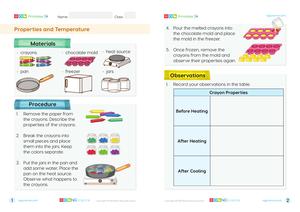Begin the lesson by discussing the concept of reversible changes in matter, using simple examples like water turning into ice and back into water.
Go to the LessonLearning Objectives
- Understand the concept of reversible changes in matter.
- Identify examples of reversible changes, including water turning into ice and back into water.
- Recognize that melting and solidifying are reversible changes, using crayons as an example.
- Explain how temperature changes can cause reversible changes in matter.
Introduction and Hook
Introduce the idea of 'undo' changes in everyday life, like melting and solidifying crayons.
Direct Instruction
Explain the concept of reversible changes using water and ice as examples. Discuss how temperature changes can cause these transformations.
Guided Exploration
Engage students in a discussion about other reversible changes they observe in their environment, like melting butter or chocolate.
Hands-On Activity
Conduct an experiment with crayons: melt them and then let them solidify to demonstrate reversible changes.
Independent Practice
Ask students to find examples of reversible changes at home and document their findings with drawings or photos.
Check for Understanding
Review and Reflection
Discuss the experiments and findings with the class. Encourage students to share their observations and insights.
Assessment and Extension
Administer the 'Review – Changes to Matter' assessment to reinforce learning and ensure comprehension of reversible changes.
Try the Quiz




